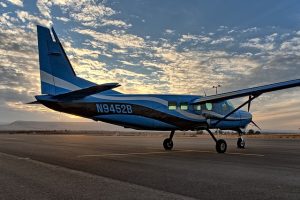
Ever wonder how high turboprop airplanes fly? Commercial airliners have an average cruising altitude of 32,000 to 42,000 feet, meaning they fly about six or seven miles above sea or ground level. Commercial airliners, however, are typically powered by jet engines, such as turbofans. So, how high do turboprop airplanes fly?
What Is a Turboprop Airplane?
To better understand their average cruising altitude, you must first familiarize yourself with the basics of turboprop airplanes. A turboprop airplane is a type of aircraft that’s powered by one or more propeller-driven engines.
Turboprop engines or simply “turboprops” feature an air intake, compressor, combustion chamber, propelling nozzle and turbine. They connect to a propeller via a set of gears. While the propelling nozzle provides some thrust, most of the thrust generated by a turboprop engine comes from the propeller.
25,000 to 30,000 Feet
While cruising altitudes vary depending on many factors, most turboprop airplanes fly at about 25,000 to 30,000 feet above ground or sea level. There are exceptions to this rule, but 25,000 to 30,000 feet is the average cruising altitude for a typical turboprop airplane.
Why Turboprop Airplanes Fly Lower Than Commercial Airliners
As you can see, turboprop airplanes have a lower cruising altitude than commercial airliners. There are several reasons for their lower cruising altitude.
For starters, turboprop airplanes don’t benefit from the cold air at high altitudes like their jet engine-powered counterparts. The air is colder and less dense at high altitudes. Jet airplanes use this to their advantage to achieve less drag and improve efficiency.
Another reason turboprop airplanes fly lower than commercial airliners is their propellers. Propellers are designed to cut through the air. When an airplane’s propeller turns, it will displace the surrounding air. The propeller will cut through the air while simultaneously pushing the air behind it. This will, in turn, propel the airplane forward. But propellers don’t work well at high altitudes.
Air density decreases as the altitude increases. If a turboprop airplane flies too high, its propeller will struggle to produce thrust. The thin air will interfere with the propeller’s operations. Even if the propeller turns, it will displace less air at high altitudes than at low altitudes. The end result is less propulsion.
In Conclusion
With their lower cruising altitudes, turboprop airplanes are more susceptible to turbulence and weather. But there are several reasons for their lower cruising altitudes, such as those listed here.



